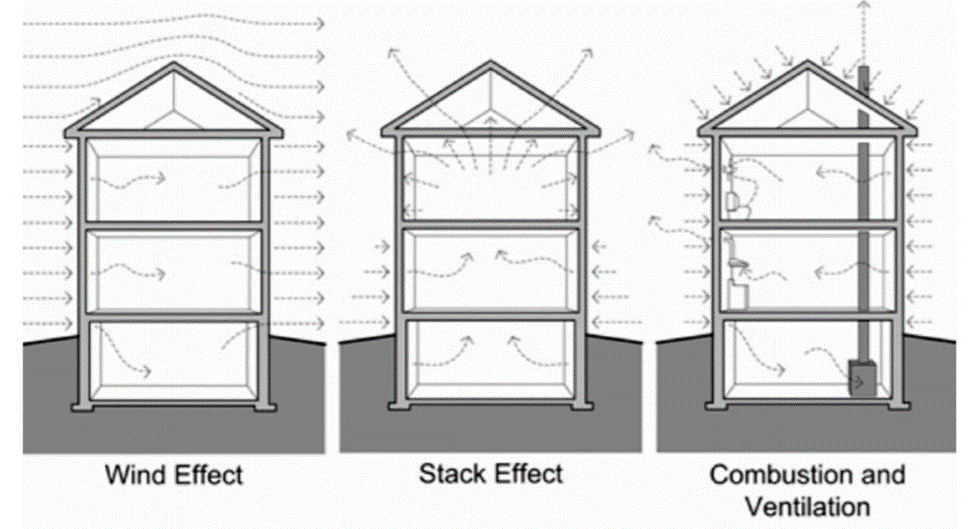
ACCA Residential HVAC Standards: Manual J – Load Calculations, Manual D – Duct Design, and Manual S – Equipment Selection: Part 5
Part 5: Infiltration and Ventilation Air – Impact on Load Calculation
This discussion is the fifth in a series on the design a residential HVAC system in accordance with ACCA Manuals J, D, and S, as requirement by the ICC mechanical and energy codes. The focus is the importance to accurately identify the additional load placed on an HVAC system by infiltration and ventilation air. Let us start by re-visiting a couple of definitions.
Definitions:
INFILTRATION. Uncontrolled inward air leakage to conditioned spaces through unintentional openings in ceilings, floors and walls from unconditioned spaces or the outdoors caused by pressure differences across these openings resulting from wind, the stack effect created by temperature differences between indoors and outdoors, and imbalances between supply and exhaust airflow rates.
VENTILATION. The natural or mechanical process of supplying conditioned or unconditioned air to, or removing such air from, any space.
VENTILATION AIR. That portion of supply air that comes from the outside (outdoors), plus any recirculated air that has been treated to maintain the desired quality of air within a designated space.
The key concept here is the load calculation for every building includes either the unintentional or intentional introduction outside air into the building envelope. We heat and cool our buildings for comfort, simply because we want our homes warmer than outside in the winter, and cooler in the summer. As the cold or hot air enters our building through infiltration or ventilation, additional heating and cooling loads are added to the total building load. These loads increase with outside temperature extremes, just as loads due to conduction through building components increase with temperature extremes. It is relatively easy to identify the quantity or CFM of air introduced through ventilation, as we can calculate and measure the volume introduced by an outside air intake or discharged through an exhaust termination. It is a little harder to accurately identify the volume of air leaking into and out of a building. Please consider the following talking points about envelope air leakage or infiltration:
-
-
- All building envelopes leak, some a lot while others just a small amount.
- Leakage increases whenever a pressure differential is created between an interior space and the exterior.
- Wind increases leakage.
- Stack effect, or heat rising creates a lower pressure at lower levels and increases pressure at higher levels. This is also referred to as chimney effect.
- Combustion appliances drawing combustion air from inside result in increased leakage through the envelope.
- If air is exhausted, it will be replaced with an equal volume of replacement infiltration air into the space.
- Exhaust systems may be installed to remove contaminant and moisture from kitchens, bathrooms, and laundry rooms.
- Other exhaust systems, HVAC ventilation air intakes, or HRV/ERV systems may be installed as whole house ventilation systems, ensuring air quality.
- HVAC systems often lack low resistance return air paths from each supply outlet, back to a return air inlet. This creates a positive pressure in for example, bedrooms rooms with closed doors, hence, a restricted path back to return air inlets. Conversely, a negative pressure is created where the returns are located. In these situations, the return path unfortunately is partially through the bedroom walls to outside, then back into the home through exterior living space walls.
-

Default Air Change Values
Manual J includes Tables 5A & 5B, which help us make an educated guess for the infiltration rate in a home. The Tables includes a description for a Tight, Average and Loose home, based on air sealing practices followed during the construction process and subsequent improvements. For example, a Tight home has all seams, joints, penetrations sealed by meticulous craftmanship, includes tight fitting backdraft dampers on all exhaust, includes only direct vent gas appliance, and sealed fireplaces. An Average home includes homes where reasonable efforts have been made to seal the building envelope, with typical inexpensive backdraft dampers and combustion appliances draw air from inside the home. A Loose home is the opposite, with no effort to seal, and combustion appliances and fireplaces open to the interior of the home.
Tables 5A & 5B, recognizing there are many homes which fall somewhere in between the three described conditions, include Semi-tight, where conditions are approximately between Tight and Average, and semi-loose, where conditions are approximately between Average and Loose. (See partial Table 5A below) The typical home built today is Semi-tight; however, Tight homes are occasionally built. Once we have identified the default construction ID for a home, the Table provides an Air Changes per Hour (ACH) value, for heating and cooling, and for homes of various volumes. Infiltration CFM is calculated using this formula:
CFM = [(ACH X AGV) ÷ 60]
Where AGV = Above Grade Volume
Dividing by 60 minutes/hour converts cubic feet per hour to cubic feet per minute

This default method is only one of several methods which may be used to determine the ACH due to infiltration. A second analysis of individual components described in Tables 5C & 5D requires additional time and effort, for possibly improved accuracy; however, both analysis methods remain educated guesses.
Many energy efficiency organizations, DOE, ASHRAE, other industry experts, and the IECC recognizes testing is the only way to truly quantify air leakage. The IECC has mandated blower door testing for most climate zones, included all of Utah, for three code cycles. Unfortunately, this requirement has been amended in Utah, making the test optional. Blower door testing will eventually become common place, due to code improvements and as builders and subcontractors realize the efficiencies of testing to identify leaks, followed by improved building practices. For additional information on blower door testing, see other code discussions, classes, videos and guides on blower door and duct testing.
Once we have identified the volume of air introduced into a home by infiltration and ventilation, these values are inputted into the Manual J process for the calculation of the required BTU’s per hour due to infiltration and ventilation.
Please consider taking a little time to open your Manual J, and review this process, ensuring calculations accurately reflect the impact of outside air on the total building load. Thanks again for your input.
Note: Images provided courtesy U.S. DOE-Building Energy Codes Program.
Brent Ursenbach
[email protected]

0 Comments